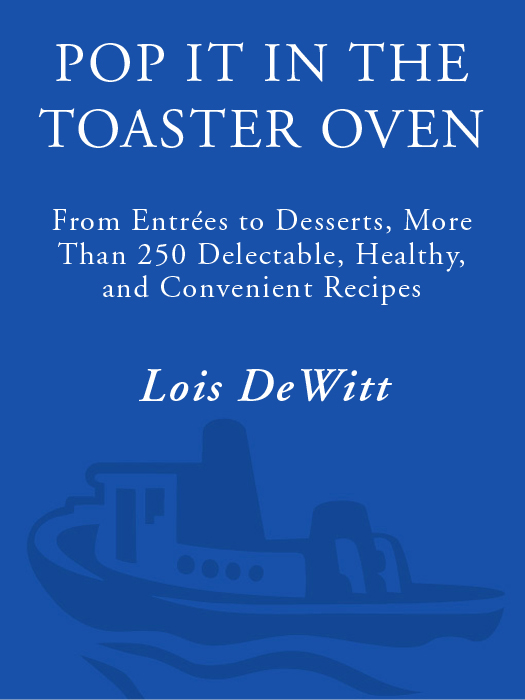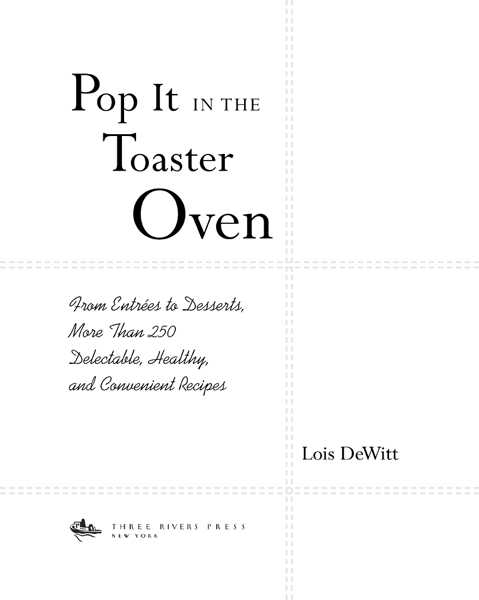My gratitude to Catherine Houck, who initiated the writing of this book, and to Samantha DeWitt for providing inspiration and support.Contents
Introduction
Y ou may be asking, What can my toaster oven
really do? Perhaps you think that a toaster oven cookbook consists of nothing more than a hundred dreary variations on toasted cheese sandwiches. But youd be mistaken! The toaster oven can go far beyond just toasting. The BROIL function can caramelize sugar, saut onions and peppers, and produce stir-fries, crisp hash browns, and quick cake layers for a torte. The BAKE function makes perfectly cooked grains, soups, and casseroles. And because all the uncooked ingredients are combined in a baking dish and baked to completion, theres the added advantage of no watched pot. The TOAST function produces excellent sunny-side up eggs and omelets.
In fact, an awesome variety of healthy meals can be created in a toaster oven via one or more of the standard functions and using only one third to one half the energy required by a full-size oven! The recipes included in this book need only a toaster oven and call for a minimum of procedures, utensils, and dishes. Most require just one dish or pan for baking, broiling, or toasting to completion. Reliably, the results are delicious. By baking and broiling, nutrients are retained and flavors concentrated. Using the toaster oven functions, its easy to make low-fat meals, sophisticated in taste and texture, using herbs and spices for flavoring instead of fats, oils, rich gravies, and sauces. Soon youll be asking yourself, What cant my toaster oven do? Choosing a Toaster Oven There are dozens of brands and models priced from $30 to $300.
I recommend choosing a well-known brand. They have a better warranty, are easier to use, and have more updated safety features than inexpensive, lesser-known brands. Consider doing a little research before you browse the stores. If you do a search of toaster ovens on the Web, you will be amazed at the wealth of consumer information that is available. There are several websites that inform consumers on toaster oven safety and hazard alerts, such as UL.com (Underwriters Laboratories Inc.), WRAL.com, and the Consumer Reports website (consumerreports.org). Current consumer buying guides can also be a good source of the latest documented reviews of toaster oven brands and models.
When narrowing down your choices, consider not only the prices, but also the wide range of features, such as:
Capacity: This refers to the interior size, measured by cubic feet (length by width by height in inches) or by how many slices of bread you can toast at once. Cool-touch exterior: The exterior is made of a heat-resistant material that inhibits exterior radiation of heat. Advancing oven rack: The oven rack automatically comes forward when you open the toaster oven door. Removable crumb tray: With a nonstick coating, it should be easily accessible and slide out for convenient cleaning. Keep-warm cycle: This refers to a postbaking function that keeps food warm for a limited amount of time. Broiler function: Most medium-to large-size toaster ovens have this function.
Research the features of several toaster ovens to compare the broiling range temperatures. Thermostat temperature: Some models have a 450 F. limit, while others go up to 500 F. Easy-cleaning interior: The interior is coated with a nonstick material that facilitates cleaning. Convection feature: A fan circulates air during baking or broiling, reducing cooking time. Timer: This comes with a bell or chime to announce the end of toasting, baking, or broiling time. Size: Choose a model that fits the space where you plan to put it. Size: Choose a model that fits the space where you plan to put it.
A four-to six-slice toaster oven will give you the best options, from toasting bread and bagels to roasting a 3-pound chicken and for trying all of the wonderful recipes in this cookbook without having to downsize the proportions!
Toaster oven sizes and capacities vary depending upon the make and model. As a frame of reference for proportioning the recipes, I used a medium-size, moderately-priced four-to six-slice-capacity toaster oven with an interior measuring 11 inches wide 5 inches high 5 inches deep. Its functions included: timed TOAST, BAKE to 450 F., and BROIL . If you have a smaller toaster oven, it may be necessary to reduce the quantities of ingredients by one half. For instance, if the recipe calls for 1 cup of flour, reduce the quantity to cup, making sure to reduce all of the ingredients by the same standard of one half. Baking or broiling times will be shorter, but not necessarily half of the given time.
Calculate about three quarters of the time and note the actual cooking completion time on the recipe page. If you have a larger toaster oven, you can expand the recipes to whatever you need as long as the total portions still fit your toaster oven. With an increased quantity, you may want to slightly increase baking or broiling times as well. By using your toaster oven frequently, you will get a feeling for its capacity and cooking times. A Brief Toaster Oven History The toaster, invented in 1909, was originally an appliance with a wire heating element and trays that could hold bread slices upright for browning. Ten years later, the pop-up toaster, with its slots and timer, became popular.
The earliest model toaster ovens, on store shelves in the late 1950s, were no more than toasters with a horizontal ovenlike rack that held two to four slices of bread. Some models had one or two low baking temperature options and, being poorly insulated, they radiated a tremendous amount of heat during baking. Over the years, the insulation, capacity, BAKE , and BROIL functions improved, addressing the needs of a growing market. Todays toaster ovens are vastly improved in performance, with all sorts of features, including cool-touch exteriors, nonstick interiors, interiors that can be removed for easy cleaning, nonstick removable crumb trays, touch-pad controls, dual racks, defrosting and light pastry options, timer controls, auto off, and even bread-making capabilities. These new features have created a more versatile appliance that not only toasts bread and bagels, but can bake or broil just about anything a large oven can without heating up the kitchen or escalating the electric bill. Keep in mind that toaster ovens are essentially small ovens.
They are not, however, to be confused with microwaves, even though they are about the same size. A baked potato still takes forty or fifty minutes to bake in a toaster oven as it does in a regular oven and a casserole still requires thirty to forty minutes. What then, you may ask, are the benefits of baking or broiling in the toaster oven? The first benefit is the flavor. A baked potato is much tastier than a microwaved potato and baked vegetables are more flavorful and have a better texture than the bland taste and rubbery texture that microwaving, boiling, or steaming often produces. This is because baking allows moisture within the food to slowly evaporate, concentrating flavors within the fiber of the food itself. The high direct heat of broiling seals the surface of the food, creating a browned, crusted surface while the center is flavorfully moist.








